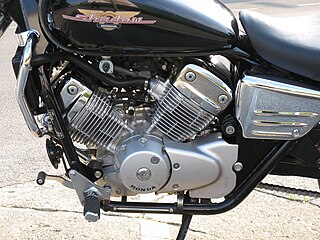
A V-twin engine, also called a V2 engine, is a two-cylinder piston engine where the cylinders are arranged in a V configuration and share a common crankshaft.

A straight-twin engine, also known as an inline-twin, vertical-twin, or parallel-twin, is a two-cylinder piston engine whose cylinders are arranged in a line along a common crankshaft.
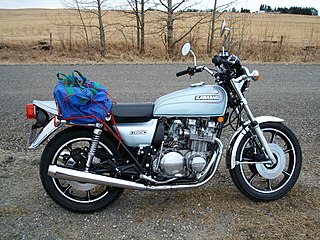
The Kawasaki Z650 was produced as a 652 cc (39.8 cu in) standard motorcycle by Kawasaki from 1976 until 1983. It had a four-cylinder four-stroke, DOHC, air-cooled, wet sump engine positioned across the frame with two valves per cylinder and a five-speed gearbox. Designed as a middleweight version of the Kawasaki Z900, the similar-styling had "an attenuated version of the traditional Kawasaki tail fairing". It competed in the market against the smaller SOHC Honda CB650. The Z650 was the epitome of the "Universal Japanese Motorcycle" (UJM).
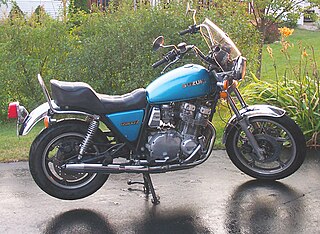
The Suzuki GS series was Suzuki Motor Corporation's first full range of 4-stroke powered road motorcycles, having previously almost exclusively manufactured 2-stroke machines. Suzuki had produced the 4-stroke Colleda COX 125cc and 93cc 4-stroke single-cylinder machines in 1955 however the rest of Suzuki's production from 1952 to 1976 had been increasingly sophisticated two-stroke road machines, whose ultimate expression was the 750cc 3-cylinder water-cooled GT750.
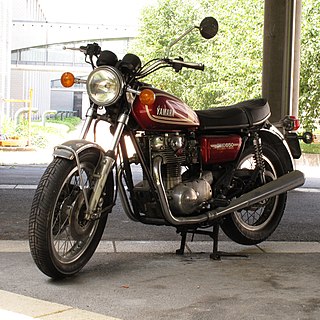
The Yamaha XS650 is a mid-size motorcycle made by Yamaha Motor Company. The standard model was introduced in October 1969,and produced through 1979. The "Special" cruiser model was introduced in 1978 and produced through 1985. The XS650 began with the 1955 Hosk SOHC 500 twin. After about 10 years of producing 500 twin, Hosk engineers designed a 650 cc twin. Later the Hosk company was acquired by Showa Corporation, and in 1960 Yamaha had bought Showa with Hosk's early design of 650 cc twin.
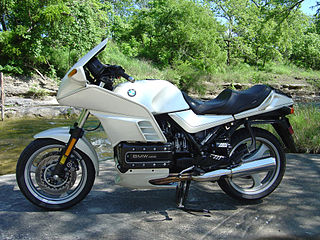
The BMW K100 is a family of four-cylinder 987 cc motorcycles that were manufactured by BMW from 1983 to 1992.
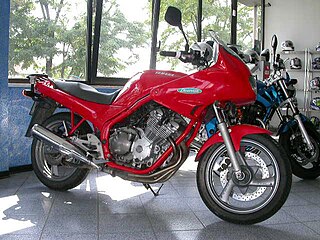
The Yamaha Diversion is a series of all-round touring motorcycles descended from Yamaha's earlier XJ series. Early Diversion models had a four-stroke air-cooled 8-valve inline-four engine. In 2009 the model name was retained for a new range with 16-valve liquid-cooled engines.
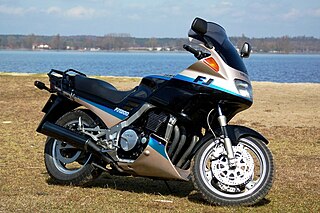
The Yamaha FJ1100 and FJ1200 are sport touring motorcycles that were produced by Yamaha between 1984 and 1996.

A motorcycle engine is an engine that powers a motorcycle. Motorcycle engines are typically two-stroke or four-stroke internal combustion engines, but other engine types, such as Wankels and electric motors, have been used.

The Yamaha XJ900 is a motorcycle manufactured by Yamaha from 1983. It was a development of the original Yamaha XJ model, the XJ 650, which was the foundation for the entire XJ series.

The Honda Sabre was a motorcycle made by Honda from 1982 to 1985. Two years of the Sabre production run were part of a group of Japanese motorcycles that came to be known as "tariff-busters". The 1984 and 1985 models fell in this class because of the modifications made allowing those models to circumvent the newly passed United States International Trade Commission tariff that placed a heavy tax on import/foreign motorcycles with 700cc or larger engine displacement.

The Suzuki Boulevard S40 is a lightweight cruiser motorcycle manufactured by the Suzuki Motor Corporation for the Japanese domestic market, and exported to New Zealand, North America, as well as to Chile and other countries.

The Yamaha XS Eleven motorcycle, also called XS11 and XS1100, is a Japanese standard produced from 1977 (MY1978) to 1983, powered by an air-cooled 1,101 cc (67.2 cu in) 4-stroke, DOHC inline four-cylinder engine mounted transversely in a duplex cradle frame with swingarm rear suspension, shaft drive, and telescopic forks.

The Yamaha FZ750 is a sports motorcycle produced by Yamaha Motor Corporation between 1985 and 1991. The FZ750 is notable for several reasons, perhaps the most radical being the 5-valve cylinder head with a radial arrangement. This became something of a Yamaha trademark. The FZ750 would be the first bike in the Genesis design concept.
BMW Motorrad is the motorcycle brand and division of German automotive manufacturer, BMW. It has produced motorcycles since 1923, and achieved record sales for the fifth year in succession in 2015. With a total of 136,963 vehicles sold in 2015, BMW registered a growth of 10.9% in sales in comparison with 2014. In May 2011, the 2,000,000th motorcycle produced by BMW Motorrad was an R1200GS.

The Yamaha XJ750 is a motorcycle made by Yamaha Motor Company from 1982 to 1985. It has a 750 cc four-stroke, four-cylinder, air cooled, naturally aspirated dual overhead cam engine with a bore of 65 mm and stroke of 56.4 mm.
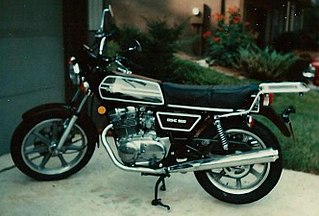
The Yamaha TX500 is a two-cylinder standard motorcycle built by Yamaha and sold in 1973 and 1974. Early models closely resembled the Triumph Bonneville in style. In 1975 the bike was renamed XS500 and then continued to be updated until 1978 when sales ended in the USA. In Europe, the model was available through 1980.

The Honda CB650 is a 627 cc (38.3 cu in) standard motorcycle produced from 1979 to 1985. It featured a four-cylinder, SOHC, air-cooled, wet sump engine, with two valves per cylinder. The CB650 was a development of the CB550, itself derived from the even earlier CB500. The CB650 was the last of Honda's successful series of air-cooled SOHC fours that began in 1969 with the Honda CB750.

The Laverda 1000 is a series of 981 cc (59.9 cu in) air cooled DOHC triple motorcycles produced by the Italian manufacturer Laverda between 1973 and 1988. The high-performance variant, the Jota, was the fastest production motorcycle from 1976 to 1981. Approximately 7,100 triples of the various models were produced.





















